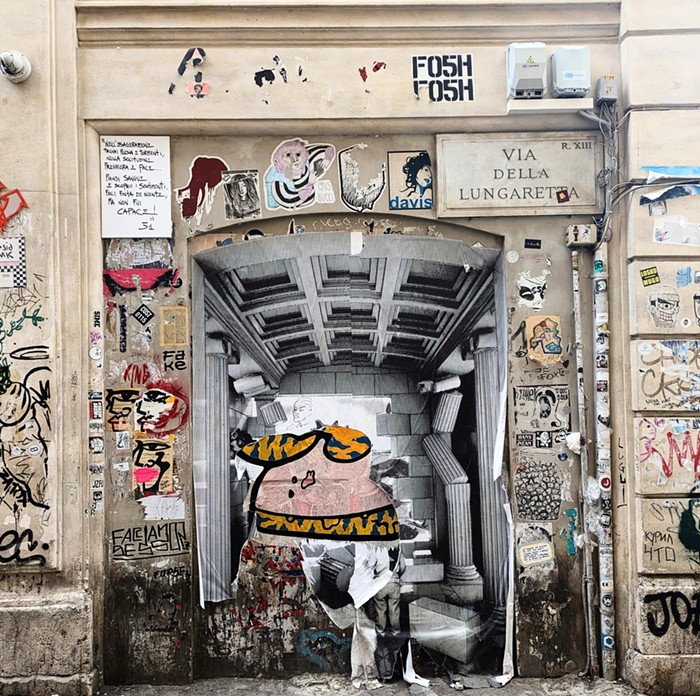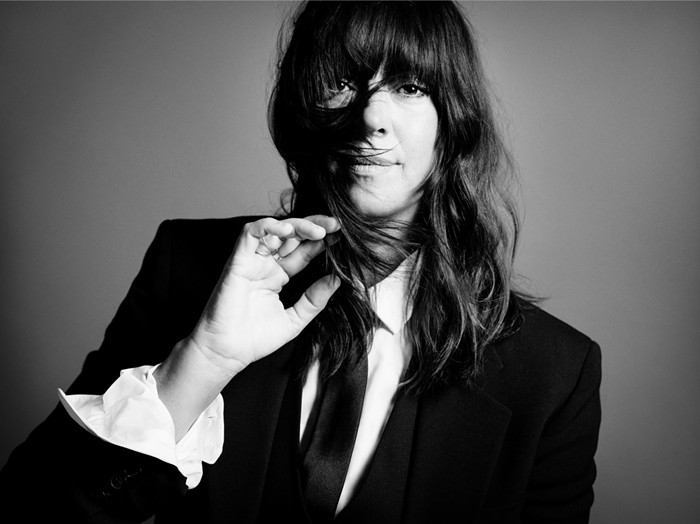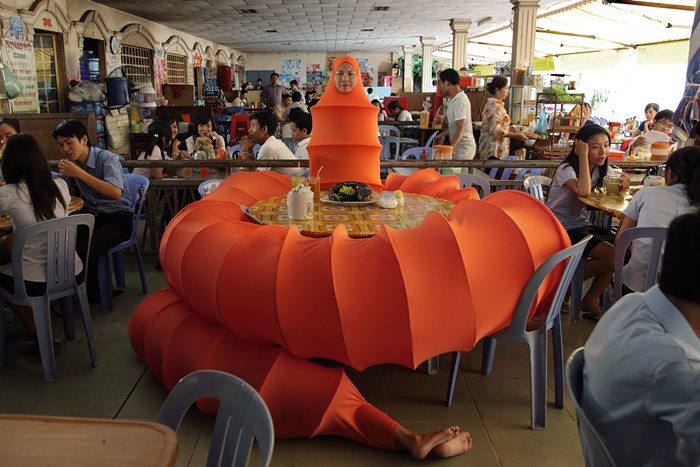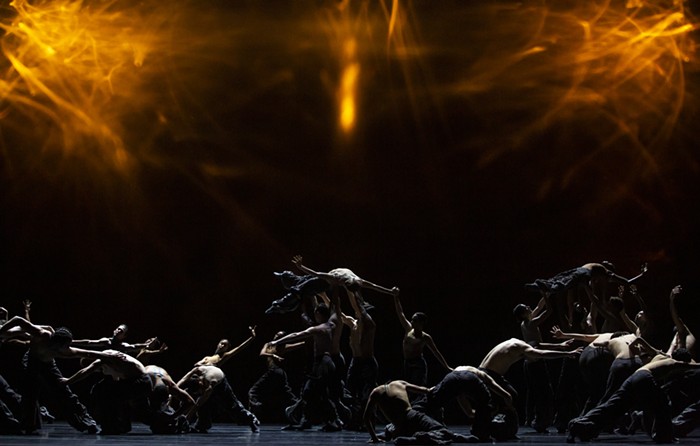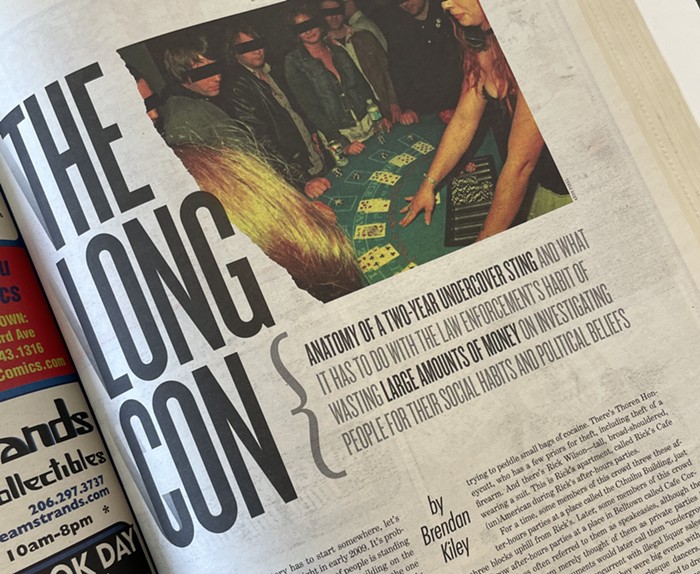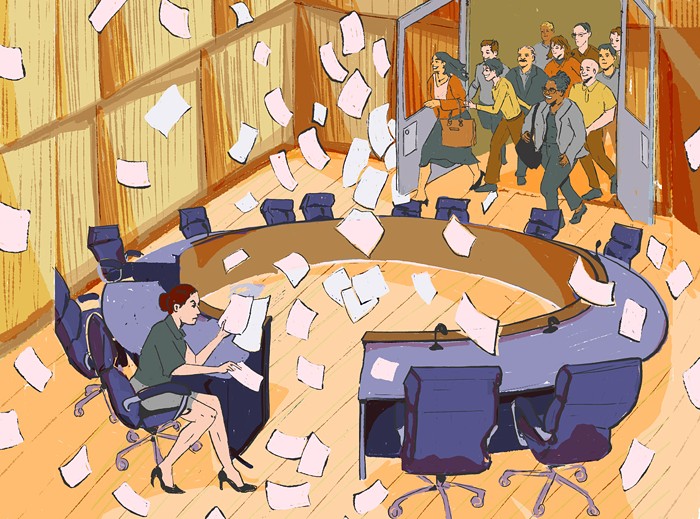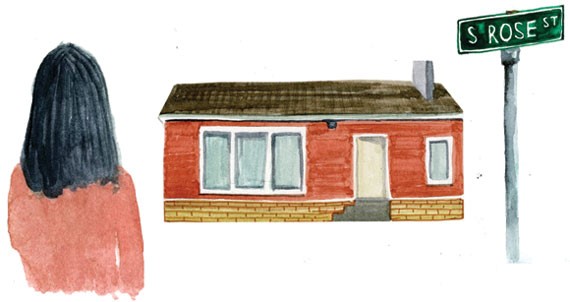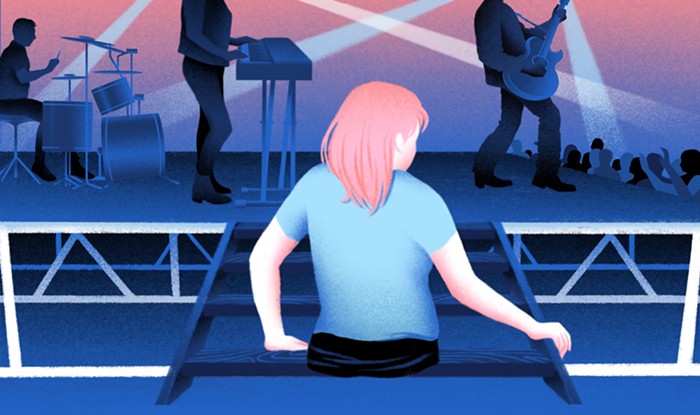Alice Wheeler has been taking extraordinary photographs for almost three decades, and every one is pure Wheeler. She's most known for her visions of Nirvana at their most innocent (many, unfortunately, in black-and-white), but her later works apprehend what didn't die with Kurt Cobain: the low-down, pioneer-meets-meth-lab weirdness of the Northwest behind the corporate facades. Girl with Bowie Shirt, Hempfest, Seattle has all the Wheeler hallmarks: the genderfucking, the masking and projection of identity, the nuclear color, the beautiful landscape harboring histories of wiped-out natives and Green River killer victims. Above all these, the vital element is the two-way gaze—one outsider (Wheeler) recognizing another outsider.
Two hundred yellow-and-black-striped canaries flew free—in a museum. White walls had turned dark and warm by the sooty licks of a billion candles, wood floors were covered with hand-placed metal plates, and freestanding glass vitrines held piles of cast wax heads. The entire place was made strange and symbolic. This ineffable promenade of installations—people are still murmuring about it—happened because the Henry Art Gallery, under the direction of Richard Andrews, removed all typical resistance and gave itself completely to the artist. The interaction between museum and artist became a part of the art and a part of the history of the city: It was the high point of the Henry transforming into its best self, a contemporary art museum driven by artists.
Straight across the Columbia River Gorge from the Maryhill Museum of Art—a concrete mansion with peacocks and Rodins and chess sets from around the world—a perfect skeleton twin of the museum stood for a single summer. It was made of scaffolding and shiny blue construction netting. Annie Han and Daniel Mihalyo (working under the name Lead Pencil Studio) conceived and designed it in Seattle, then put their materials on a truck and assembled their full-sized mirror out there in the middle of nowhere, on empty land, harnessing the across-the-gorge doubling of the earth itself. The unlikeliness of this project invited you to consider the scale of the unlikeliness of constructing the original concrete mansion in the first place. It was a home before it was the Maryhill Museum of Art, on a brutally windswept expanse of deserty nowhereness—well, it was supposed to be a home. A man made it for his family, but his family refused to move in, preferring to stay back East. Maryhill Double was rooted in this specific history, of one lonely Seattle pioneer's stubbornness despite lifelong personal and professional failures (too many to list). Usually, museums are proud places of social and cultural triumph. The Double tenderly revealed a different story.
The Miss Havisham of the Seattle skyline: Not just bony, ghostly, and once idealistic, the white arches that appear out of nowhere and serve no function have gotten more interesting with time. Now they echo the charred remains of the Twin Towers, which Minoru Yamasaki designed: It was these white arches that attracted the World Trade Center commissioners to Yamasaki in the first place.
This is the most radical work of public art in the region: four white porcelain walls in two toilet stalls at the Greater Tacoma Convention & Trade Center (one stall in the women's room, one in the men's room, unmarked from the exterior). The porcelain blocks buckle at the edges as if they'd exhaled and collapsed, and what looks like white frosting (caulk) seeps in at the seams. On the surface are breastlike shapes with nipple holes, asking to be sucked or touched or worse. In a bathroom, where we most aggressively manage bodily embarrassments, they come back with a cold vengeance. This architecture doesn't cooperate in covering up and flushing away, doesn't do what architecture usually does (idealize your body, give you a safe and neat outer shell, manage your waste). This architecture calls out unidealized you.
Two same-species lovers with long protuberances: Jeffry Mitchell poses gay love as ridiculously encoded, only discussable via elephants or elephantine euphemisms, or in childish terms. There are difficult ideas here (and considered traditions, too, like the Quaker pickle jar the underlying form is based on), but you come to those later. First you hit the surface: a forest pile of flowers and berries and vines and tree branches and pretzels and hidden rabbits and a horseshoe and what looks like the face of a bear. These are fat fleshy loops made out of breakable ceramic, coated—but only coated, and only lightly—in the refinement of pretty white and platinum luster. Underneath, in the earthenware itself, unperfected finger pinches and crude little marks are still visible: There's always the memory of softness. Instead of irony there is wonder, humor, humility, and a warmth so intense you may as well call it love. Actually, that's it: No other Seattle artist has come close to producing as much sheer love as Jeffry Mitchell.
Charles Krafft went to war-torn Sarajevo in the 1990s and met with an arms dealer. He returned home with a cast for an AK-47, which he filled with porcelain. Out came AK 47, a lovely tribute to the weapon Krafft calls the "little black dress" of the modern military. It's not the only aggressive work of art Krafft has made out of decorative, domestic materials. He's made grenades in the style of Delftware, china from human cremains, and birthday cakes for white supremacists. "The best weapon [society] has for dealing with dangerous art," Arthur C. Danto writes, is "the theory that art, in its very nature, is innocuous." Krafft likes to call bullshit on that theory as often as he can. His art calls out both the potential that art might be dangerous (and censored, as his has occasionally been) and the tragic joke that it's not. Krafft sells plenty of art. Naturally, as the Northwest's best iconoclast, he goes without gallery representation.
It was part of a sprawling exhibition, which only two people (its organizers) ever saw all of, called 557,087. That was the population of Seattle at the time. Boundary was made out of black-and-silver labels attached to telephone poles and street signs. They read, "Boundary: A section of a city, especially a thickly populated area inhabited by minority groups often as a result of social or economic restrictions." This was only a year after Seattle voted to end racial housing discrimination, and this "boundary" contained the Central District, making visible something that was real but unmarked—and marking it in a cool, bureaucratic tone. Art tourists seeing it had to have wondered if the residents of the neighborhood knew the signs were there. Residents who did know had to wonder: What the fuck? (Did someone put a sign on our back?) And what did you need with you to cross over this boundary? How would you know if the boundary was even in the "right" place? It's an explosive public work, with staying power: Boundary could be remade today, if anybody had the guts. Where's the ghetto now?
Morris Graves was both the jester (see below) and the hippie priest of the four "Northwest mystic" artists, so dubbed by Life magazine in 1953. This painting, born in Seattle but now living in the collection of the Museum of Modern Art, really has two creators: The bird is pure Graves (he'd been bird-watching—and identifying with birds—since he was a sickly kid), but the web of white lines enveloping the bird is stolen from fellow mystic Mark Tobey's "white writing" technique developed in 1935. Graves ripped Tobey off, no question—but it's a transformative theft. Tobey's Asian-calligraphy-influenced abstraction was cold, theoretical, and East Coasty. Graves's was warm and personal but transcendental, too. A young World War II soldier who became an art scholar confessed later that, in battle, it was his memory of Bird Singing in the Moonlight that comforted him.
This disinvitation was sent to everyone on the Seattle Art Museum mailing list. It was ignored. They thought it was a joke. According to the Seattle Times, "They arrived by droves, some formally dressed, to find the gateway to his house blocked with a table that held the moldy remains of a banquet 10 days old, complete with tipped cups and wine stains, soaked with the drizzle from an overhead sprinkler. A recording of 'dinner music' was interspersed with a recorded pig fight. Graves stayed out of sight, laughing nonstop." Anti-art (finally) had arrived in Seattle.
The feminist artist Mierle Ukeles washed the front steps of museums. She dusted the art. She called it Maintenance Art, and it resembled the tasks of every woman at home: Why couldn't women's work be artwork? For an exhibition in Seattle, she assigned Anne Focke, a founder of the and/or gallery, the task of thinking of her maintenance of the gallery as art. In doing so, Ukeles unknowingly transferred the task to one of the only people in the history of Seattle ever to make administration into a lifelong work of art (it's ongoing). The work that and/or was doing at the time is legend, although it's hard to find any information about it except from Focke herself—who didn't want to talk about it because she hates "best of" lists, to her credit.
This is the only work in the Olympic Sculpture Park that knows that the rest of the work in the Olympic Sculpture Park is sedate and/or dead. It is a giant, locally found nurse log (a dead log) in an outbuilding made especially for it, with sciencey tools on metal carts and wall tiles painted with species that live on or near nurse logs and a mobile shelf of related reference books, addressing art's aspirations to educate. (People have talked about spotting a mouse in the log, but this has not been confirmed.) This artificial environment is managed by the museum overseers, but only to an extent: Nobody knows exactly what will happen, or even what is going on in the log right now. The things growing out of it carry with them the eternal prospect that they'll outgrow their building—a seedling busting through the glass one day would be grand—and start inhaling the unrarefied air of downtown.
It was a white wheel made of milk-carton paper, 17 feet in diameter and 32 inches thick at its bulging center, suspended from the ceiling of Suyama Space. It had a hole in its side, through which was a view of the structure holding it up: more paper, all paper, graduated circles of paper spiraling in on themselves—a whole world of elaborate, hidden, flawless geometry. The wheel, which had been built in 32 individual wedge-shaped forms, could be pushed into making slow revolutions; along with this deliberate motion went the steady, monotonous sound of drips of water falling into buckets on the floor. Duty Cycle (which alluded to Bruch's 1980s performances feeding homeless people in Pioneer Square) was an homage to labor for labor's sake, a piece that represented nothing so much as the time the artist lost in making it, the product of an unglamorous process that nevertheless added up to something regal and fragile. Duty Cycle was a thing with as little existential logic as a person: anti-heroism at its best.
Freeway Park is like a craggy mountain on its head; the summit is at the bottom. You climb down elaborate descending stairs to stand on a narrow plane with a bracing view. But this isn't a vista. You face an ugly metal screen. A thin slice of waterfall rushes in front of it, falling from the top of the park. Through the water and the metal, you can see the subject you came all this way to look at: cars flying by under an orangey electric light, inside the concrete tunnel of Interstate 5. It's as if the park were here first, and then the city sprung up around it, interrupted it, completed it.
There is no place like the Seattle Central Library, but it is not an icon and its specialness has nothing to do with uniqueness of form. Its shape—vaguely like a great hip thrust toward the water—is odd, but in the way that a machine's innards are odd: A logic is there to be discovered, though it immediately escapes you. The main area on the Fifth Avenue level is a marvel of openness that's not blank or empty or simple or romantically American-Western, but contained and organized, which is emphasized by two major features: a giant and unadorned concrete shaft in the center of the space and the relentless, soaring pattern of diamonds composing the building's glass-and-steel skin. Getting through the library requires learning its inconvenient patterns, which then still trip you up at certain places—fine. Knowledge is Byzantine and laborious. You can't get around this library on autopilot. It is not "natural" in its progression, yet the top public floor, glass to the sky, is landscape poetry.
In 1970, New York native Jacob Lawrence—a national art star since the 1940s for his series of paintings of the black migration northward—came to Seattle to teach at the University of Washington. The Migration series is Lawrence's masterpiece. But here his attention pivoted from the past, and he started painting the future being built: He saw in Seattle a place full of people who work with their hands, people united (across race and gender) in labor, applying ancient tools to the endless-seeming resources of the Northwest. What they're building is never quite in view. It's the act of building itself that matters. The series is signature Lawrence: saturated colors, bulky forms, jangling perspectives. Artforum called it "Carpenter Cubism." Today it's Obamanian.
The Center on Contemporary Art, now a shell of itself, began spectacularly in 1982 by turning over an empty Pioneer Square building to an artist who filled it with no objects at all for six mind-blowing months. Inside instead were four glowing installations of light (three of them new) that disrupted the distinction between object and environment, between light and space, between solid and ephemeral: You perceived yourself perceiving them. James Turrell is now a household name—his meditative "Skyspaces" are fixtures at museums around the country, including the Henry Art Gallery, and he's sculpting an entire crater in Arizona—but his 1982 works instantly established in Seattle a tradition linking modernism, spirituality, and installation.
This sculpture in Myrtle Edwards Park on the Elliott Bay waterfront is literal: It is a big, dumb thing you can sit on. Three cement bases of varying shapes are paired with granite pieces from a quarry at Skykomish. The pairs are lined up from left to right (if you're facing Elliott Bay) as a visual enactment of the title: the granite adjacent to the cement, then against it, then upon it. Nothing is memorialized or metaphorized; this monument is present tense all the way. Most people either laugh at it or miss it. Michael Heizer more commonly sculpts giant geometric shapes in the middle of Southwestern deserts, but in this—his first major urban commission, it just so happens—he is forced to carve out a human space in the slim border zone between sublime water and mountains and urban core. These blocks are furniture for meditations about scale.
Nature in paint: Making it as direct as possible is the task, right? Alden Mason responded—for a few years only, before moving into another style entirely—with great big canvases that are a mix of Morris Louis (who stained his canvases in mysterious studio pours and died before specifically explaining) and Willem de Kooning (who could make a painting look as though it had a million layers and colors—and maybe it did). Mason's abstractions are essentially living landscapes, bubbling and oozing even now.
You walk into a 90-foot-long (or 60-foot-long, depending on the iteration) darkened corridor lined on each side by life-size figures: glowing, ghostlike. They're video projections. As you walk toward each figure, you activate the video, and the person-phantom walks toward you, looks straight at you, then turns and walks away. You're almost meeting another human, but it's a half presence and partly a mirror of yourself. What inspired this understated marvel of technologically enabled and disabled interactivity—a hit at Documenta IX and the 1993 Whitney Biennial, now in the collection of the Henry Art Gallery—was a photograph taken in Seattle around 1930 of a tall ship on the sea. Tall Ships haunts the lonely, technological imagination of the Northwest.
It's a fact: Dan Webb can spring anything out of a block of material. Nobody else in Seattle can do that. He could make big, perfect, lasting sculptures forever. But the contrasting fact that he can't control time is the never-ending subject of his bittersweet art. His masterpiece is Little Cuts, made in honor of his brother, who died of a brain tumor. It's not an actual carving but a series of photographs of the process of making a carving. The earliest photos show a block of wood; then a man's head carved out of that wood; then, gradually, that same man's skull; then a nub; then nothing. Along with these photographs—40 of them—a Plexiglas box full of the sawdust is on display: an urn. Dust is agonizing in the midst of such acts of creation.
The world's most famous glass artist is actually far more talented as an organizer. 100,000 Pounds of Ice and Neon was his best event. He first experimented with embedding neon in ice in 1971, at the Rhode Island School of Design; he did it again in 1992, on the streets of downtown Seattle, to coincide with his solo show inside the brand-new Seattle Art Museum, for a piece called 20,000 Pounds of Ice and Neon. But the version of the installation he made in 1993 in Tacoma was in another realm: It was indoors, on the skating rink at the Tacoma Dome, and five times heavier—100,000 pounds of ice and neon shaped into seven-foot-high orbs and tumbleweeds and slabs like popsicles for giants. The Tacoma Dome had opened 10 years earlier with a neon-art controversy that nearly shut down public art in the city, which happens to be Dale Chihuly's hometown. He brought neon back and converted the doubters: In two days, 33,000 people came to see the installation, dubbed "ice-henge"—for free—in the dark interior of the dome, where the ice didn't just melt, but melted, rolled down to the rink, and froze again into secondary mounds around the bases of the bent neon tubes before the whole thing disappeared completely.
No list like this would make any sense without native art, and yet most everything that passes for the native art of Seattle is actually art from hundreds of miles north of here. Only in the last few decades have the Salish-speaking people, the real native people of this coastal-turned-urban region, begun to reclaim their lost and undervalued traditions. This mountain-goat-hair robe—the first such robe to be made in a century—woven and hand dyed with native plants by Susan Pavel, is not just a robe: It is a she, a feminine entity with a mission, as one Skokomish spiritual leader says. She (robe) commemorates the "sacred change" of rediscovering Salish ways and is meant to inspire future generations. The vertical dashes are backbones, urging strength even in struggle; the tied ends on the robe's fringes are a reminder not to leave things undone. She is a soft monument.
On Labor Day of 1993, the unknown artist Jason Sprinkle attached a ball and chain around the ankle of the largest sculpture in Seattle, Hammering Man, the very well-known sculpture outside Seattle Art Museum by the very well-known artist Jonathan Borofsky. Sprinkle took care when he did it. He padded the chain so it wouldn't damage the other artist's work. Seeing this care, Borofsky allowed the intervention to stay up for a week. It wasn't just a protest; it was a proposed collaboration that gave the sculpture tension, made it work.
There is a great work of art being made right now that will never be seen, or never be seen by critics, or that will be seen and overlooked—making this list necessarily incomplete. It is by someone who hasn't studied art, or by someone spray-painting the street, or it is the product of a career artist who decides that it isn't any good and has to be destroyed. Despite its ability to be or to do something that matters, even something very small, it will be melted down, cut up, painted over, passed by, or shoved into a drawer—it will join many others like it. I wish I had found it. ![]()
To see alternate lists by selected members of Seattle’s art establishment, click here .

